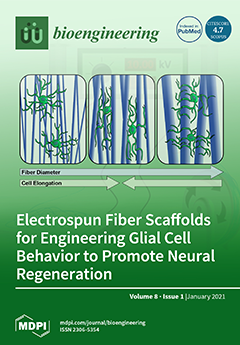A novel generation of gels based on medium chain length poly(3-hydroxyalkanoate)s,
mcl-PHAs, were developed by using ionic interactions. First, water soluble
mcl-PHAs containing sulfonate groups were obtained by thiol-ene reaction in the presence of sodium-3-mercapto-1-ethanesulfonate. Anionic PHAs were physically crosslinked by
[...] Read more.
A novel generation of gels based on medium chain length poly(3-hydroxyalkanoate)s,
mcl-PHAs, were developed by using ionic interactions. First, water soluble
mcl-PHAs containing sulfonate groups were obtained by thiol-ene reaction in the presence of sodium-3-mercapto-1-ethanesulfonate. Anionic PHAs were physically crosslinked by divalent inorganic cations Ca
2+, Ba
2+, Mg
2+ or by ammonium derivatives of gallic acid GA-N(CH
3)
3+ or tannic acid TA-N(CH
3)
3+. The ammonium derivatives were designed through the chemical modification of gallic acid GA or tannic acid TA with glycidyl trimethyl ammonium chloride (GTMA). The results clearly demonstrated that the formation of the networks depends on the nature of the cations. A low viscoelastic network having an elastic around 40 Pa is formed in the presence of Ca
2+. Although the gel formation is not possible in the presence of GA-N(CH
3)
3+, the mechanical properties increased in the presence of TA-N(CH
3)
3+ with an elastic modulus G’ around 4200 Pa. The PHOSO
3−/TA-N(CH
3)
3+ gels having antioxidant activity, due to the presence of tannic acid, remained stable for at least 5 months. Thus, the stability of these novel networks based on PHA encourage their use in the development of active biomaterials.
Full article






